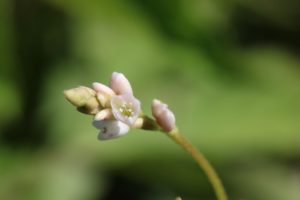Friends in Low Places

Pennsylvania smartweed
There are many plants I like, and many more I appreciate. The Gray-headed Coneflower, such a pretty symbol of the prairie. The stately, jagged Compass Plant, towering overhead on thick, fuzzy stems. I like marigolds in the garden, and my one variety of tomato that I grow from seeds year to year. I appreciate all the milkweed varieties for their role in Monarch life cycles, and the humble violet for its early cheer after long, bitter winters.
But there are a couple of plants for which I feel a special affinity. They are the plants that always provide a little thrill whenever I encounter them in the wild, and I greet with a silent “Hello, friend.” They are fairly common, humble plants and I have no explanation for the affection I feel beyond a faint image of them at the periphery of my youthful wanderings in nature. Some–if I’m being honest, many–would consider them base weeds, lacking gaudy flowers or attractive foliage, if they consider them at all.
The first I have already featured on this blog: the hardy pineapple weed (Matricaria discoidea), denizen of alleys and sun-baked roadsides, with its fringes of leaves topped with plain, pointed cones of disc florets.
 The other is smartweed, more specifically Pennsylvania smartweed (Persicaria pensylvanica), sometimes referred to as a “noxious weed” of agricultural areas. With pretty clusters of tiny pink and white flowers, Pennsylvania Smartweed is a native that thrives in disturbed areas (much like the pineapple weed, though the smartweed prefers more moisture).
The other is smartweed, more specifically Pennsylvania smartweed (Persicaria pensylvanica), sometimes referred to as a “noxious weed” of agricultural areas. With pretty clusters of tiny pink and white flowers, Pennsylvania Smartweed is a native that thrives in disturbed areas (much like the pineapple weed, though the smartweed prefers more moisture).
It closely resembles the non-native Lady’s Thumb (Persicaria maculata); both have similar flowers and stems with swollen nodes (their family name, Polygonaceae, meaning “many knees,” refers to the resemblance of these nodes to knees), and the nodes are wrapped in a membrane called the ochrea. They both may also have a reddish spot on their leaves, from which Lady’s Thumb derives its name. Pennsylvania smartweed and Lady’s Thumb can be distinguished by examining the ochrea: Lady’s Thumb has a fringe of bristles around the top of the ochrea, which Pennsyvania smartweed lacks.
I always think of the flowers of these plants as little closed balls, but a closer look reveals a more typical floral structure, with individual flowers opening in turn, being pollinated by a variety of pollinator friends, and then closing again around the developing shiny, dark seed. Though it is considered of little value to humans, Pennsylvania smartweed provides a source of food for many birds, small mammals and even turtles.
I can’t explain my affection for smartweeds and pineapple weeds, beyond hazy nostalgia. It could be the contrarian in me, determined to appreciate those things that are so often overlooked or even reviled as an offense to horticultural decency. Regardless, I consider them scrappy little friends, popping up here and there with a familiar silhouette among all the diversity the world has to offer.
Originally published in Sycamore Greenway Friends.
Tags: Melissa Serenda, Pensylvania smartweed, pineapple weed

